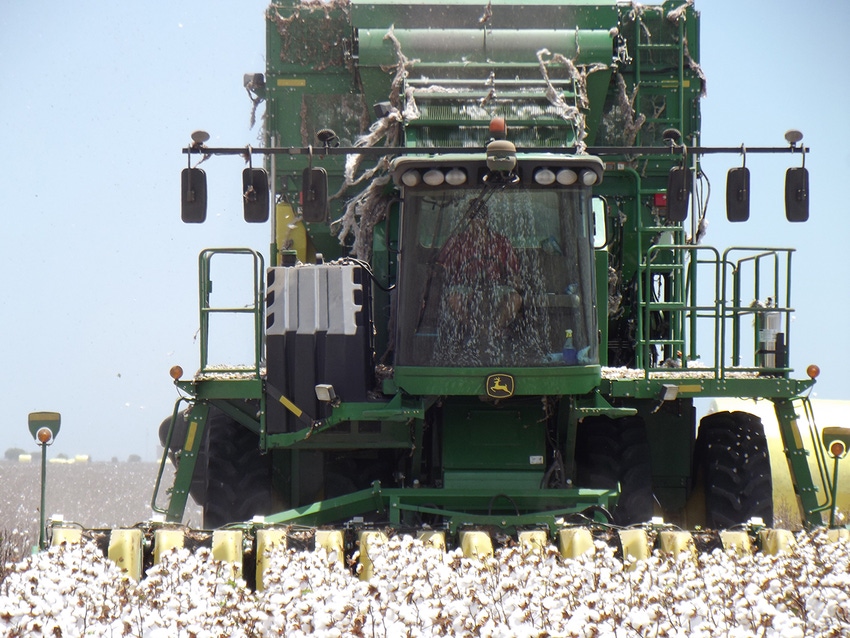
With cool weather followed by heavy rains in early spring that disrupted planting schedules and torrential storms that flooded fields in April and again in late May that added to their troubles, farmers across the lower Texas Coastal Bend and in the Rio Grande Valley were concerned about making decent grain and cotton crops this year.
But with a good grain harvest in June and a successful cotton harvest beginning to wrap up in South Texas, many producers are expressing not only relief but also satisfaction over good yields and overall positive results to a crop year that was challenged by floods, pests, high input costs and unstable prices.
"I'm very pleased with the season so far. On the positive side we had pretty good grain harvests in June, though the price for grain wasn't all that good. But we are catching a little break with cotton," says Travis Wanoreck, a Coastal Bend farmer who was busy over the weekend wrapping up harvest on just over 2,000 acres of South Texas cotton.
Wanoreck farms about 1,200 acres in Bee County and 850 acres in Nueces County on leased land.
"On my best fields we managed just over 3 bales of cotton an acre in Bee County and around 2 bales an acre in Nueces County," he said. “My best fields, which are irrigated by a pivot system, measured about 3.2 bales per acre."
Wanoreck owns and operates TWB Farms in Robstown and says he couldn't be more pleased with this, his first year in the farming business. Formerly a rep with Helena Chemical as a precision agriculture technician, he says farming is what he always aspired to do, and says so far it's been a great start to his new career. He said farming has been a goal at least as far back as his days at Texas A&M, where he graduated with a degree in Agriculture Management.
For the latest on southwest agriculture, please check out Southwest Farm Press Daily and receive the latest news right to your inbox.
Since completing harvest in his cotton fields, Wanoreck is now contracting out harvesting services to other area farmers who are trying to beat tropical rain showers forecast in the days ahead as a low pressure system moves in from the Gulf of Mexico.
He shares a lease on cotton strippers with his uncle, Gene Gully of Mereta, Texas, his business partner, who also farms cotton in Tom Green County in West Texas.
"This way we can share in the costs of this expensive enterprise. Folks who don't farm can't appreciate the high costs involved in farming," a problem he says needs to be corrected. "Even before I started farming, I would hear some people say farmers are making huge profits. They don't realize it's a touch and go business, nor do they understand the investment it requires to even get started."
Wanoreck represents a new breed of young farmers who are willing to risk the challenges of modern farming. Economists say with the average age of farmers growing every year, young farmers are in short demand, especially since so many are reluctant to get into agriculture because of the capital required and the risks involved.
AREA COTTON HARVEST UPDATE
In San Patricio County, Agricultural Extension agent Bobby McCool reports about 35 percent of cotton has been harvested so far in his area.
"There's gonna be a few 3 to 4 bales cotton per acre yields in parts of our area on the high side. I think we're going to average just above 2 bales per acre across the county, however," McCool estimated. "Gins didn't really open up until the last week or so of July and many farmers who have finished harvest are waiting to get back reports from ginners on just how well they did in terms of quality and quantity."
But he warns a few counties east of San Patricio and Aransas counties that received heavier rains in the spring may not be yielding as well once harvest gets underway in coming days.
Record rainfall caused extensive flooding in many fields across multiple counties in the Upper Coastal Bend in April and May, and the result was damaged or destroyed crops, replanted fields, or stunted or inconsistent growth for some cotton.
In Wharton County, Upper Coast Extension IPM specialist Kate Harrell reports bolls had cracked in late July but reports cotton harvest won't get underway for at least another week or two.
She reports corn and grain sorghum harvest was wrapping up, however, with good results reported. But she said stink bugs and boll worms were pressuring cotton in some fields in recent weeks.
In the Lower Rio Grande Valley, cotton harvest is nearing completion. Texas AgriLife crop specialists report yields range as low as a bale-and-a-half in fields that suffered pest, disease or weather pressure. But yields range between 2 to 2.5 bales per acre average on most dryland cotton, and better than 3 bales per acre on irrigated fields, with a few reports of 4 bales per acre of more in isolated areas.
In the Valley, pest pressure from mostly whiteflies affected some cotton, but spraying efforts helped to prevent serious crop damage.
While cotton prices were down slightly mid-week (Aug. 10, 2016) to just over 71-cents, last Thursday (Aug. 4) cotton futures hovered above the 75-cent mark, a two year high, giving producers some cause for optimism late in the South Texas cotton season.
About the Author(s)
You May Also Like




